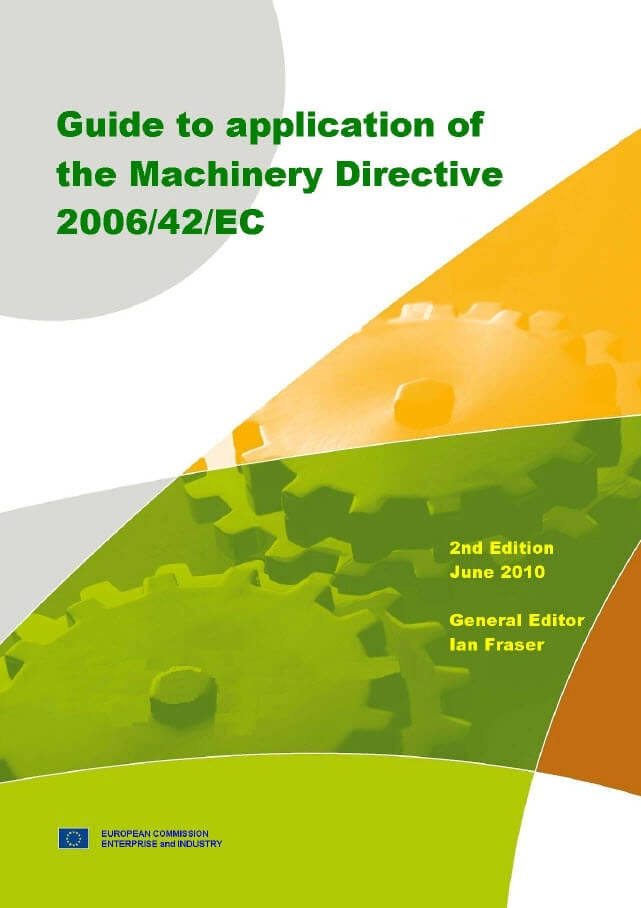Guide to ISO 20607: Instruction Handbooks for Machinery
19/01/2024 Law & Legislation
Creating user manuals that comply with the long list of requirements of the Machinery Directive is a challenging task. In this guide I’m going to show you how the ISO 20607 standard for creating instruction handbooks for machinery can help you to create better instructions.
Finally, a standard has been developed that specifically focuses on creating instruction handbooks for machinery. If you want to make sure that you fulfil all legal, market, and regulatory obligations for your machinery, applying the ISO 20607 standard is an absolute must. Not only will the standard help you to comply with the Machinery Directive, it will also help you to create instructions that support your users to work with machinery safely.
Let’s get this started!
DOWNLOAD THE MACHINERY CHECKLIST AND SEE IF YOUR MANUAL COMPLIES
DO YOU WANT TO CHECK IF YOUR DOCUMENTATION COMPLIES?
We can check if your technical documentation and manuals comply with the ISO 20607 standard and the European Directives.
The ISO 20607 standard in a nutshell
The ISO 20607 standard for Instruction Handbooks has been developed by ISO, the International Organization for Standardization.
In one of my other articles, I discuss the 82079-1:2019 standard for Information for Use. This standard has been developed under the IEC/IEEE umbrella. There is a relationship between the two standards.
At the moment that the development of the IS0 20607 standard started, the committee was not yet aware of the revision of the 82079 standard. When they did become aware of this fact, the scope changed.
The current 20607 standard is now based on the 82079 standard and should be seen as an enhancement to the 82079 standard that contains additional guidelines for developing instruction handbooks for machinery specifically.
Many guidelines, as described in the 82079 standard have not been repeated in the 20607 standard, such as how to write clear texts or apply the principles of minimalism.
So what are the shortcomings of the 82079 standard and what does the 20607 standard include that the 82079 standard does not cover? In other words: why do we need a standard for machinery only?
The 20607 standard provides safety specifications for machinery that are more specific than the 82079 standard. There is a strong relationship between the ISO 12100 standard for risk assessment and risk reduction.
ISO 12100 standard is intended for machinery only, so this standard has not been taken into account for the development of the 82079 standard .
The 82079 standard is developed for a broad scope of products, ranging from toys to machinery and leaves it up to the technical writer to decide what requirements to use for a specific product, regardless whether this is a toy, machine or medical device.
Therefore the scope of the 20607 standard is described as “specifying requirements for the machine manufacturer for the preparation of the safety-relevant parts of an instruction handbook for machinery”.
The 20607 standard covers all provisions from section 1.7.2.4. of the Machinery Directive and therefore covers the Directive in full (except for the requirement on noise emission as this is covered by other standards). The 82079 standard does not specifically cover all these provisions of the machinery directive.
Because the 20607 standard should be considered as an addition to the 82079 standard , both standards should be applied when you are creating an instruction handbook for machinery.
When you apply both standards (as soon as they are harmonised) when developing your instruction handbook, you create the highest possible presumption of conformity with the corresponding requirements of harmonisation legislation.
According to the 20607 standard, the purpose of an instruction manual created in line with the standard is to inform the readers in such a way that after they have read the manual, they know how to use the machinery safely according to its intended use during the entire life cycle of the machinery.
The ISO standard is a type-B standard. Type-B standards are standards that deal with specific aspects of machinery safety, whereas type-A standards specify basic concepts (such as the EN ISO 12100) and type C standards provide specifications for a certain category of machinery.
But like the 82079 standard, the 20607 standard still provides general guidelines to follow in order to comply with the Machinery Directive. It remains up to the technical writer to use these guidelines to create clear and safe instructions for a specific type of machinery.
As an example, the 20607 standard states that the instruction handbook must include installation instructions. However, it is not described in much further detail what these installation instructions must contain exactly.
So, focussing on machinery and as an enhancement to the 82079 standard, the 20607 standard covers the following topics:
- Content and structure of the instruction handbook;
- Language and formulation/style guide;
- Forms of publication.
The reason that the content and structure is part of the standard, is to comply with section 1.7.4.2 of the Machinery Directive. This section clearly describes the content of the instructions for machinery.
The content of machinery often differs from the content of other product groups. For example, for machinery you should include a spare part list or commissioning instructions. This kind of information is of less significance for toys.
Language requirements for machinery differ slightly from those of other products. I will discuss that later.
Also, the form of publication will be discussed later in this article. The 20607 standard creates much more freedom when it comes to electronic distribution of instruction handbooks, compared with how this was interpreted in the Guide to Application of the Machinery Directive.
Let’s discuss the main topics of the 20607 standard in further detail.
The relationship between the 20607 and 12100 standards
ISO 12100 is the standard for risk assessment and reduction of machinery. Basically, there are three ways to reduce risks that are related to the use of machinery.
Risks can be reduced by improving the design, taking safety measures, or by providing information, such as warnings and instructions. Risk reducing measures have to be conducted in the described order.
As such, the ISO 12100 standard considers the drafting of information for use as an "integral part of the design of a machine".
A standard that specifically gives requirements about the information for use for machinery has always been obsolete. The ISO 20607 standard fills this gap and provides further requirements on information for use.
The terms and definitions that are used in ISO 12100 also apply to the ISO 20607 standard and/or have been taken over, such as instruction handbook.
The instruction handbook is defined as "the part of the information provided by the machine manufacturer to the machine user that contains instructions and advice concerning the use of the machinery during all phases of its life cycle".

The relationship between the 20607 and the Machinery Directive
- The business name and full address of the manufacturer and of his authorised representative;
- The designation of the machinery as marked on the machinery itself;
- The EC declaration of conformity;
- A general description of the machinery;
- The drawings, diagrams, descriptions and explanations necessary for the use, maintenance and repair of the machinery and for checking its correct functioning;
- A description of the workstation(s);
- The intended use of the machinery and its reasonably foreseeable misuse;
- Warnings concerning ways in which the machinery must not be used that experience has shown might occur;
- Assembly, installation and connection instructions, including drawings, diagrams and the means of attachment and the designation of the chassis or installation on which the machinery is to be mounted;
- Instructions relating to installation and assembly for reducing noise or vibration;
- Instructions for the putting into service and use of the machinery and, if necessary, instructions for the training of operators;
- Information about the residual risks that remain despite the inherent safe design measures, safeguarding and complementary protective measures adopted;
- Instructions on the protective measures to be taken by the user;
- The essential characteristics of tools which may be fitted to the machinery;
- The conditions in which the machinery meets the requirement of stability;
- Instructions with a view to ensuring that transport, handling and storage operations can be made safely;
- The operating method to be followed in the event of accident or breakdown;
- The description of the adjustment and maintenance operations that should be carried out by the user and the preventive maintenance measures that should be observed;
- Instructions designed to enable adjustment and maintenance to be carried out safely;
- The specifications of the spare parts to be used, when these affect the health and safety of operators;
- The following information on airborne noise emissions:
- The A-weighted emission sound pressure level at workstations, where this exceeds 70 dB(A); where this level does not exceed 70 dB(A), this fact must be indicated,
- The peak C-weighted instantaneous sound pressure value at workstations, where this exceeds 63 Pa (130 dB in relation to 20 µPa),
- The A-weighted sound power level emitted by the machinery, where the A-weighted emission sound pressure level at workstations exceeds 80 dB(A).
- Where machinery is likely to emit non-ionising radiation which may cause harm to persons, in particular persons with active or non-active implantable medical devices, information concerning the radiation emitted for the operator and exposed persons.
ISO 20607: Use terminology and wording wisely to create a clear handbook
ISO 20607 emphasises that the instruction handbook must be comprehensible and that the use of standardised terms, recognisable technical terms and explanations of terms that are necessary to use is the way to meet this requirement.
Also, the handbook must be as simple and as brief as possible. This can, for example, be achieved by enhancing text with pictograms and drawings, the use of simple sentences and avoiding the use of synonyms.
Tables and bullet lists can present some information clearer than long texts. Chronological, logical and sequential writing will make instructions easier to understand.
Using a proper writing style and right vocabulary ensures that readers can understand information in the handbook more easily.
Always begin instructions with the goal. This can be “changing the oil” or “installing the machinery”.
Always take the target group into account when writing your instructions. Avoid using jargon and use wording that the reader is likely to understand.

The use of common technical writing principles, such as the use of consistent, accurate, unambiguous and and simple wording is recommended by the standard as well.
Annex C - Recommendations for writing instructions gives guidelines and recommendations for sentences and words that preferred and those that should be avoided.
For example, the appendix states to use the active voice and gives ‘clean the machine’ as a preferred example and ‘make sure that the machine is clean’ as the non-preferred example.
Over 20 other guidelines are listed in Annex C with an evenly balance of preferred and non-preferred examples. The guidelines include directions on the use of references, unambiguity, the use of nouns vs. pronouns etc.
A clear instruction can contain the following parts:
- The number of the step;
- The instruction itself;
- The purpose or reason of the instruction;
- The effect of the instruction/checking if the instruction has been completed successfully.
Example:
- Press the FORWARD button. The machine now starts riding.
In order to be clear, warnings should contain the signal word, the nature of the hazard, any possible injury or damage and information on how to avoid damage.
Example:
DANGER! Highly corrosive chemicals. Risk of severe eye and skin injuries. Avoid contact Wear eyes and body protection.
Include all the content relevant for each phase of the life cycle
The Machinery Directive gives requirements for the content of the instructions. Also the ISO 12100 standard requires the inclusion of all content that may be used during the full life cycle of the product.
As an answer to this, the 20607 standard provides an example of how a handbook can be structured. In other words: how the table of contents of handbook could look like. A typical user manual includes, amongst others, a title page, a safety sections, follows the entire life cycle of the machine (transportation, assembly, operation, troubleshooting et cetera) and end with an index,gloassary and some annexes.
A table of contents should always be tailored to the needs of the user of the specific machinery.
Section 5 of the ISO 20607 standard describes this structure of a handbook in much further detail. This is definitely where the 20607 standard is a great addition to the 82079 standard and where most of the Machinery Directive requirements can be perfectly met.
As the ISO 20607 standard distinguishes itself from the 82079 standard by giving more specific requirements on the safety specifications for machinery, let’s have a closer look at this section.
A great improvement of the 20607 standard compared to other standards in regard to information for use, is the requirement to include safety information where the task is described, meaning that you should warn the user where a risk could occur.
Practically, this can be at the beginning of a section or embedded in a specific step. All safety requirements that do not apply to an indivisual task or sections, can be presented in the chapter at the beginning of a user manual containing all general safety instructions.

Example of an instruction with an embedded safety message
All warnings about potentially hazardous situations that can occur during the intended use and reasonably foreseeable misuse must be given.
Also, the operating method to be followed in the event of accidents or breakdowns must be included. For example, this can be a description of the location of the emergency stop or the instructions to get medical support.
A description of the fire-fighting equipment to be used shall be given as well. When oil or gas catches fire, the use of fire-fighting equipment using water should be avoided.
When possible emission or leakage of hazardous substances can occur, information on this has to be provided. If applicable, instructions on how to fight their effects shall be given.
This video explains exactly how to determine all legally required content for your operator manual:
How to present and format your instruction handbook
You can create a single instruction handbook or a set of separate documents. For example, you might want a separate document for the installation, maintenance or use of a machine. Other reasons to split a handbook might include because a single document is too large or complex, or you want a seperate handbook for each different target group.
When you do decide to bundle all the information for different audiences into one document, make sure to clearly indicate which part is for whom.
Make sure to use fonts and font sizes that are sufficiently clear and large enough to ensure legibility. As a guideline, use an 8-point to 14-point font for paragraph-text in printed documentation.
The ISO 20607 standard contains the table that is used in the 82079 standard with minimum recommended font sizes and heights of safety signs and symbols. Safety information should be clearly recognisable from other information. This kind of information can be emphasised using bold and italic fonts, lines, frames or colours.
Use headings to help the user find what they are looking for. Short and clear meaningful headings work best. The heading ‘Replacing oil’ is more meaningful than ‘Maintenance’.
Can you publish your instruction handbook online?
This has always been a hot topic as the Machinery Directive itself is not very clear about this.
The Machinery Directive does require that ‘Before placing machinery on the market and/or putting it into service, the manufacturer or his authorised representative shall provide, in particular, the necessary information, such as instructions’.
However, it is not mentioned in which format the instructions should be provided and if this must be printed and included with the product, or whether these can be provided online.
The Guide to Application of the Machinery Directive states the following:
Section 1.7.4 does not specify the form of the instructions. It is generally agreed that all health and safety related instructions must be supplied in paper form, since it cannot be assumed that the user has access to the means of reading instructions supplied in electronic form or made available on an Internet site. However, it is often useful for the instructions to be made available in electronic form and on the Internet as well as in paper form, since this enables the user to download the electronic file if he so wishes and to recover the instructions if the paper copy has been lost. This practice also facilitates the updating of the instructions when this is necessary.
Although the Guide is not legally binding, it has always been generally agreed that user instructions should be provided in paper form, at least the health and safety related information (see also this article).
There is some movement noticebale regarding this in the 20607 standard.
Section 7 of the standard states that the instruction handbook must be provided as agreed with the customer, taking into account local legislation of the country where the machinery is placed on the market and/or put into service for the first time.
This means that in principle the handbook can be a paper handbook, placed on an electronic storage medium (such as a cd, usb-stick or on a device accompanying the machinery), published online or have a visual or auditory form.
Also the new Machinery Regulation offers a wider window opportunity when it comes to electronic instructions. Section 1.7.4 states that "The instructions may be provided in a digital format".
Does that mean that all instructions can simply be put online? We don't believe so. Only when as a result of a risk assessment it is deemed to be safe to provide the instructions in a digital format, you can do so.
See this infographic for the differences between the machinery directive and the new machinery regulation on the user instructions.

Should you translate your instruction handbook?
Also when it comes to translating your instruction handbook, the 20607 standard mentions that the agreement with the customer is leading, but again, local legal requirements should be taken into account.
This is different from what the Machinery Directive itself requires.
According to the Directive, all machinery must be accompanied by instructions in the official language or one of the official languages where the machinery is placed on the market and/or put into service.
As an exception, the Directive allows the maintenance instructions intended for use by specialised personnel mandated by the manufacturer or his authorised representative, to be supplied in only one language which the specialised personnel understands.
Also, it is remarkable that the requirement to mention whether the handbook regards the original instructions or a translation of the original instructions can’t be found in the 20607 standard.
Conclusion
Well, there is a lot to say about creating instruction handbooks for Machinery according to ISO 20607 as you can see!
And I have more or less only covered those aspects that are an addition to the IEC/IEE 82079 standard .
I think the 20607 standard is a great standard and by applying it, you don’t just create compliant instruction handbooks.
Your instructions will be super clear and user-friendly as well and your readers will simply love using your machinery.
So, create some awesome instructions and save some lives out there!
If you find that this post is helpful to you, I would appreciate it if you could leave a comment below or contact me for any inquiries.
Also, read this post on how to use a user manual template to create compliant instructions.
 |
Ferry Vermeulen is a technical communication expert and director at INSTRKTIV. It's Ferry’s mission to create digital user instructions for all products in the world. Listen to the INSTRKTIV podcast on Spotify or read one of his latest blog articles. Linkedin I Spotify I YouTube I Facebook I Twitter |
DO YOU WANT A USER MANUAL TEMPLATE THAT ALREADY CONTAINS THE LEGAL PARTS?
Take the shortest way to a compliant manual. We have developed user manual templates for machinery, toys, medical devices and electronics that contain all legal content.

